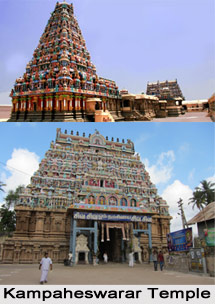 The Kampaheswarar Temple, an ancient Shiavite temple narrating the sagas of Lord Shiva, is located in the town of Thirubuvanam on the Mayiladuthurai-Kumbakonam road in the Indian state of Tamil Nadu. The Lord here is installed on a circular yonipitha housed in the sanctum sanctorum or garbhagriha of the temple. Thousands of pilgrims visiting the temple from different destinations worship the Lord in the form of Kampaheswarar as it is believed that he had prevented the quaking (Skt. Kampa) of a king who had been since long haunted by a Brahmarakshasa.
The Kampaheswarar Temple, an ancient Shiavite temple narrating the sagas of Lord Shiva, is located in the town of Thirubuvanam on the Mayiladuthurai-Kumbakonam road in the Indian state of Tamil Nadu. The Lord here is installed on a circular yonipitha housed in the sanctum sanctorum or garbhagriha of the temple. Thousands of pilgrims visiting the temple from different destinations worship the Lord in the form of Kampaheswarar as it is believed that he had prevented the quaking (Skt. Kampa) of a king who had been since long haunted by a Brahmarakshasa.
Architecture of Kampaheswarar Temple
Kampaheswarar Temple, exhibiting the architectural opulence and magnificence of the artisans of the yesteryears, stands as reminiscent of the Dravida style of architecture. One of the most unusual and unique form of the temple is its extremely high vimana that stands as a contrast to the other Dravidian style South Indian temples. The temple is adorned with ancient inscriptions inscribed on the southern side of the wall of the temple according to which the shrine was constructed by the Chola king Kulothunga Chola III in memory of his successful campaign in North India.
The presiding deity of the temple, Lord Shiva is the form of Kampaheswarar. Besides this the temple also has a separate shrine for Sarabeswarar, a fusion of man, eagle and lion. According to a legend the deity is said to have relieved the devas or gods from the rage of Lord Vishnu in the form of Narasimha after he killed Hiranyakashipu. A sculptural representation of Sharbeshwaramurti can also be seen in the Tribhuvanam temple in Tanjore district in Tamil Nadu. The deity is depicted with three legs, with body and face of a lion as well as a tail. The deity possesses four human arms. With the right upper hand he is seen holding an axe, with his lower right hand he holds a noose, with the upper left hand a deer and a fire in the lower left hand.
Narasimha is seen having eight arms, flaying and struggling under the feet of Sharbeshwaramurti. Besides these, the temple is also adorned with beautiful sculptures of Sridevi and Bhudevi, the consorts of Lord Vishnu.





















